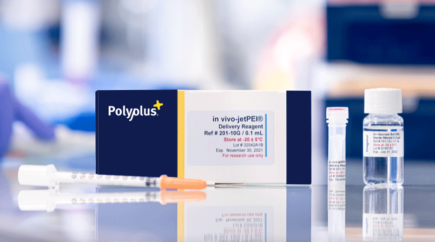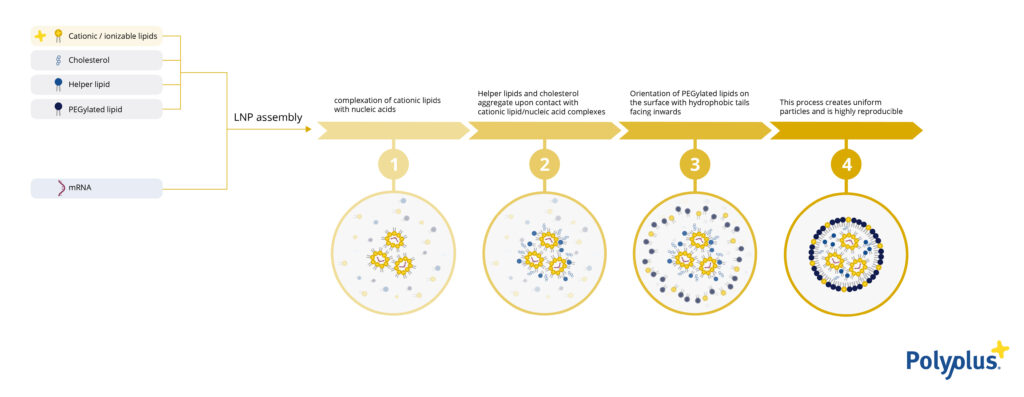in vivo-jetPEI® is a ready-to-use cationic polymer reagent recommended for in vivo transfection of DNA, siRNA, miRNA, shRNA and other oligonucleotide...

We use cookies to help you navigate efficiently and perform certain functions. You will find detailed information about all cookies under each consent category below.
The cookies that are categorized as "Necessary" are stored on your browser as they are essential for enabling the basic functionalities of the site. ...
Necessary cookies are required to enable the basic features of this site, such as providing secure log-in or adjusting your consent preferences. These cookies do not store any personally identifiable data.
Functional cookies help perform certain functionalities like sharing the content of the website on social media platforms, collecting feedback, and other third-party features.
Analytical cookies are used to understand how visitors interact with the website. These cookies help provide information on metrics such as the number of visitors, bounce rate, traffic source, etc.
Advertisement cookies are used to provide visitors with customized advertisements based on the pages you visited previously and to analyze the effectiveness of the ad campaigns.
RNA/DNA Therapeutics
New range of proprietary cationic lipids for LNP formulation
Efficient
Modulate LNP properties to adapt the biodistribution depending on the therapeutic purpose
Secure
Use a unique lipid structure protected by an independent patent owned by Polyplus®
Accelerate your project
in vitro and in vivo proof of concept have been successfully performed
Flexible
Comprehensive library enabling efficient screening and refinement to identify the perfect LipidBrick® for each therapeutic application
| Name | LipidBrick® Library |
|---|---|
| Type | Cationic lipids for LNP formulation |
| Storage | - 20°C |
| Intellectual Property | EP3646854B1 & WO2024008967A1 |
| LipidBrick® Library CAS Numbers | IM21.7c CAS# 2416939-42-7 |
DNA and RNA therapeutics offer promising new treatments for a wide range of diseases, and lipid nanoparticles (LNPs) are an essential tool in their delivery. Those treatments include both prophylactic vaccines that prevent infection by triggering the patient’s immune system and therapeutic vaccines/drugs that will be used to cure a patient from a specific disease. As the properties of LNPs influence their delivery efficacy, their stability as well as their biodistribution, each therapy will require its own LNP formulation depending on the genetic material, application, and tissue(s)/organ(s) of interest. Thus, to tailor the delivery system to the needs, a wide variety of lipids modulating the physico-chemical properties of LNP is required to ensure therapeutic success.
As an innovator in the field of nucleic acid delivery, Polyplus® has developed a new range of cationic lipids, named LipidBrick® dedicated to the formulation of lipid nanoparticles (LNPs). These active lipids protect the mRNA molecules and play an important role in the transfection capacity of LNPs. Importantly, by being based on an imidazolium polar head, LipidBrick® broadens the spectrum of current LNP applications in terms of potency and biodistribution by adding an overall positive charge to LNPs: this translates into greater delivery of mRNA to the lungs and/or the spleen while reducing accumulation in the liver compared to LNPs based on ionizable lipids.
Polyplus’ goal is to support customers from R&D to commercialization. Within the LipidBrick® library, LipidBrick® IM21.7c is the cationic lipid (active lipid) used in the formulation of jetMESSENGER® and in vivo–jetRNA®+ , allowing a seamless transition between our ready-to-use reagents and your LNP formulation finet-uned to your specific needs and applications.
Moreover, LipidBrick® is based on a unique lipid structure protected by an independent patent owned by Polyplus®.

Figure: LNP-mRNA formulation using a microfluidic system.
Table: LipidBrick® Library description
| LipidBrick® name | Linear Formula | Molecular Weight (g/mol) | IUPAC name |
| IM21.7c | C59H117ClN2 | 890.03 | 3-butyl-1-(2,6-dimethyl-14-octadecyldotriacontan-9-yl)-1H-imidazol-3-ium chloride |
| IM3c | C41H79ClN2 | 635.55 | (Z)-1-(heptatriacont-9-en-19-yl)-3-methyl-1H-imidazol-3-ium chloride |
| IM12c | C48H95ClN2 | 735.75 | 1-(2,6-dimethyl-14-tetradecyloctacosan-9-yl)-3-methyl-1H-imidazol-3-ium chloride |
| IM13c | C64H127ClN2 | 960.18 | 3-methyl-1-(24-octadecyldotetracontan-19-yl)-1H-imidazol-3-ium chloride |
| IM15c | C53H97ClN2 | 797.82 | 3-methyl-1-(7-octadecyl-1-phenylpentacosan-2-yl)-1H-imidazol-3-ium chloride |
| IM16c | C56H111ClN2 | 847.97 | 1-(2,6-dimethyl-14-octadecyldotriacontan-9-yl)-3-methyl-1H-imidazol-3-ium chloride |
| IM22c | C51H101ClN2 | 777.83 | 3-butyl-1-(2,6-dimethyl-14-tetradecyloctacosan-9-yl)-1H-imidazol-3-ium chloride |
| IM25c | C57H113ClN2O | 877.99 | 3-(2-hydroxyethyl)-1-(24-tetradecyloctatriacontan-19-yl)-1H-imidazol-3-ium chloride |

These FAQs are organized by application to guide you to find the best answer possible.

You have access to all the documents related to the transfection reagent.

Search for publications in our Transfection Database with Polyplus transfection reagents

This lexicon will help you to understand the different terms related to Polyplus-transfection®.